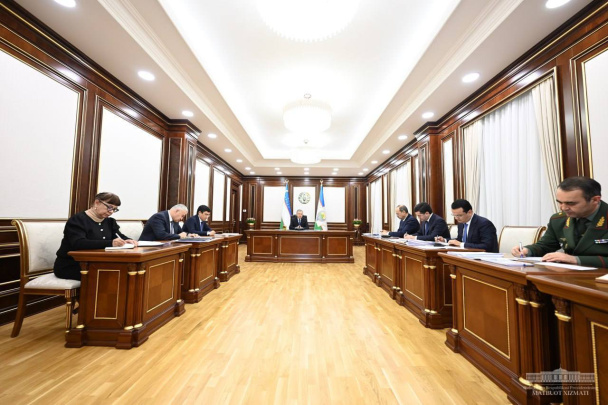Central Bank keeps refinancing rate unchanged at 14% per annum
The Central Bank has increased its general inflation forecast for 2024 to between 9-11 percent, which is attributed to the adjustment of regulated prices and the introduction of VAT on a number of goods and services starting in April.

Photo: Central Bank
The Central Bank's board decided to keep the key rate unchanged at an annual level of 14 percent during its meeting on April 25, 2024.
The impact of fundamental monetary factors on inflationary processes in the economy is gradually diminishing. At the same time, the liberalization of certain regulated tariffs from May 1 this year may have a one-time impact on general inflation.
Taking into account the updated inflation forecast corridor's upper limits, the Central Bank board decided to maintain the key rate at an annual level of 14 percent, considering that the current monetary and credit conditions have been formed in a relatively tight phase.
General inflation continued to decrease from the beginning of the year, standing at an annual rate of 8 percent in March. There was a significant decrease in inflation for food products. The dynamics of prices in external food markets had a depressing effect on import inflation.
"The high demand in the economy and the increase of some regulated prices and tariffs have led to a steady increase in services inflation over recent months. Base inflation has slowed significantly, forming lower than the general inflation level at the beginning of the year, at an annual rate of 7.6 percent in March," according to the regulator's explanation.
The inflation expectations of the population and entrepreneurs remain higher than the current and forecast levels of inflation. At the same time, due to the impact of the adjustment of regulated prices and the introduction of VAT on a number of goods and services from April, the dynamics of inflation expectations may rise.
"Taking these factors into account, according to updated macroeconomic forecasts, the general inflation forecast for 2024 has been raised to between 9-11 percent under the main scenario. The relatively wide range of the forecasted corridor is explained by the complexity of assessing the impact of these changes on the inflation expectations of the population and entrepreneurs at present. It also accommodates one-off payments, social norms, and a two-month grace period offered to the public related to the tariff increases, which may soften the effects of these changes. Solid expectations are forming that base inflation will remain on a stable downward trajectory, projected to be around 7-8 percent by the end of the year," stated the Central Bank's press release.
The preliminary level of general inflation forecasts has been increased due to the regulated price rise, which is higher than initially anticipated in the macroeconomic projections of the monetary policy's main directions. However, the impact of these changes on economy prices is of a one-time nature and not expected to significantly influence the declining trend of inflation in the medium term due to somewhat dampened consumer demand.
Additional measures directed by the government to increase aggregate supply and reduce inflation in the economy, as well as the accumulated effects of relatively strict monetary and credit conditions for a long duration, will help to curb inflationary processes.
According to preliminary data, the growth rate of the economy accelerated to 6.2 percent in the first quarter of 2024. High growth rates in the service, retail turnover, and construction sectors, as well as increased investment activity in manufacturing and mining industries, have been observed.
There is a significant increase in the labor market demand. However, there is a certain segmentation in the labor supply, and unmet demands, particularly in highly skilled sectors, are leading to higher wage growth in the relevant areas.
The real exchange rate of the UZS has devalued by 0.9 percent since the beginning of the year and has been shaped within the scope of long-term trends. No pressures are observed against the real exchange rate considering the forecasted rates and inflation of foreign trade partners.
According to updated projections, GDP growth by the end of the year is expected to be in the range of 5.2-5.7 percent. The strictness level of existing monetary and credit conditions, ensuring positive real market rates, is reflected through the progressive moderation of credit volumes in the economy and the accelerated growth of deposits.
In the upcoming quarters, the banking system's overall liquidity is expected to transition gradually from structural surplus to a phase of structural deficit, and these structural changes will be managed through monetary and credit operations.
At present, the risks of achieving the forecast for basic inflation have intensified, and if significant growth in the inflation expectations of the population is observed in future periods, appropriate measures to alter monetary and credit conditions will be undertaken.
The Central Bank is focused on achieving the 5 percent inflation target through a relatively strict monetary and credit policy, paying particular attention to the balance of demand and supply in the economy, inflation expectations, and the pace of structural reforms.
Related News

16:35 / 21.12.2024
"We will reduce the poverty rate to 6% in the coming years" – Shavkat Mirziyoyev

16:33 / 21.12.2024
Uzbekistan’s foreign trade turnover nears $60 billion in 11 months

14:56 / 20.12.2024
Uzbekistan’s banks planning to raise $6 billion without state guarantees in 2025

13:26 / 20.12.2024



